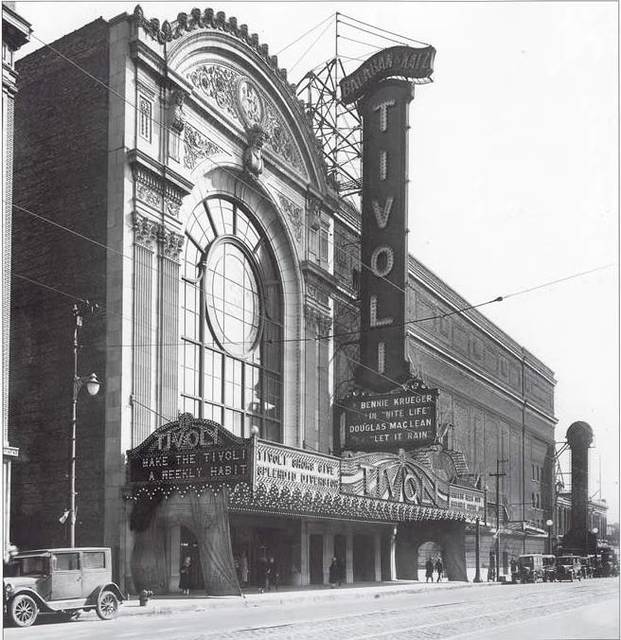Tivoli Theatre (Chicago) on:
[Wikipedia]
[Google]
[Amazon]
 The Tivoli Theatre was a
The Tivoli Theatre was a
 The Tivoli Theatre was a
The Tivoli Theatre was a movie palace
A movie palace (or picture palace in the United Kingdom) is any of the large, elaborately decorated movie theaters built between the 1910s and the 1940s. The late 1920s saw the peak of the movie palace, with hundreds opening every year between 192 ...
at 6323 South Cottage Grove Avenue, at East 63rd Street, in the Woodlawn neighborhood of Chicago
(''City in a Garden''); I Will
, image_map =
, map_caption = Interactive Map of Chicago
, coordinates =
, coordinates_footnotes =
, subdivision_type = List of sovereign states, Count ...
's South Side. It was the first of the "big three" movie palaces built by the Balaban & Katz
Balaban and Katz Theater Corporation, or B&K, was a theatre corporation which owned a chain of motion picture theaters in Chicago and surrounding areas. It was founded by Barney Balaban (later long-time President of Paramount Pictures), his six ...
theatre chain run by brothers A. J. Balaban
Abraham Joseph Balaban, known as A. J. Balaban or Abe Balaban (April 20, 1889 – November 1, 1962), was an American showman whose particular influence on popular entertainment in the early 20th century led to enormous innovations in the American ...
, Barney Balaban
Barney Balaban (June 8, 1887 – March 7, 1971) was an American film executive who was the president of Paramount Pictures from 1936 to 1964 and an innovator in the cinema industry.
Life and career
Barney Balaban (formerly Birnbaum) was the el ...
and their partner Sam Katz, who were also owners of the Rivera Theater (North Side) and the Central Park Theater (West Side), that opened on 16 February 1921.
History
The building itself, a French Baroque styled structure, was designed by architects Cornelius Ward Rapp and George W. Leslie Rapp doing business under the auspices ofRapp and Rapp
C. W. & George L. Rapp, commonly known as Rapp & Rapp, was an American architectural firm famed for the design of movie palaces and other theatres. Active from 1906 to 1965 and based in Chicago, the office designed over 400 theatres, inclu ...
. The building had an intricate design complete with gold leaf and multicolored marble decor. It was outlined with paintings and ornate sculptures. The theater was two stories high with a painted ceiling in the lobby that was meant to resemble the Sainte-Chapelle at Versailles. The theater held 3,520 patrons around one screen, had air conditioning, and the most up-to-date projection system.
The opening was a gala affair, complete with music from a 55 piece orchestra. The theater cost $2,000,000 to construct; its lobby was two stories high and was able to hold 3,000 people. About 1924-1925 Milton Charles was the resident organist who recorded for Marsh Laboratories on the Autograph label using the new electric recording system of Orlando R. Marsh Orlando R. Marsh (August 6, 1881 – September 7, 1938) was an electrical engineer raised in Wilmette, Illinois. In early 1920s Chicago, Illinois he pioneered electrical recording of phonograph discs with microphones when acoustic recording with ...
with microphones, compared to the more common acoustic method using horns. Charles succeeded Jesse Crawford
Jesse Crawford (December 2, 1895 – May 28, 1962) was an American pianist and organist. He was well known in the 1920s as a theatre organist for silent films and as a popular recording artist. In the 1930s, he switched to the Hammond organ and b ...
as a Marsh artist after Crawford went to New York to play at the Paramount Theater and eventually record with Victor Talking Machine Company
The Victor Talking Machine Company was an American recording company and phonograph manufacturer that operated independently from 1901 until 1929, when it was acquired by the Radio Corporation of America and subsequently operated as a subsidi ...
. The theater, which stood just south of the southeast corner of 63rd Street and Cottage Grove Avenue, closed in 1963 and was demolished shortly thereafter.
References
Cinemas and movie theaters in Chicago Demolished theatres in Illinois Former buildings and structures in Chicago Former theatres in the United States {{Chicago-struct-stub